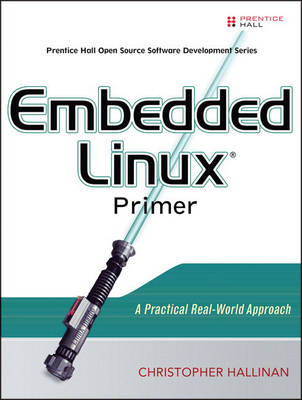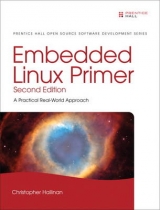
Embedded Linux Primer
Prentice Hall (Verlag)
978-0-13-167984-9 (ISBN)
- Titel erscheint in neuer Auflage
- Artikel merken
Comprehensive Real-World Guidance for Every Embedded Developer and Engineer
This book brings together indispensable knowledge for building efficient, high-value, Linux-based embedded products: information that has never been assembled in one place before. Drawing on years of experience as an embedded Linux consultant and field application engineer, Christopher Hallinan offers solutions for the specific technical issues you’re most likely to face, demonstrates how to build an effective embedded Linux environment, and shows how to use it as productively as possible.
Hallinan begins by touring a typical Linux-based embedded system, introducing key concepts and components, and calling attention to differences between Linux and traditional embedded environments. Writing from the embedded developer’s viewpoint, he thoroughly addresses issues ranging from kernel building and initialization to bootloaders, device drivers to file systems.
Hallinan thoroughly covers the increasingly popular BusyBox utilities; presents a step-by-step walkthrough of porting Linux to custom boards; and introduces real-time configuration via CONFIG_RT--one of today’s most exciting developments in embedded Linux. You’ll find especially detailed coverage of using development tools to analyze and debug embedded systems--including the art of kernel debugging.
Compare leading embedded Linux processors
Understand the details of the Linux kernel initialization process
Learn about the special role of bootloaders in embedded Linux systems, with specific emphasis on U-Boot
Use embedded Linux file systems, including JFFS2--with detailed guidelines for building Flash-resident file system images
Understand the Memory Technology Devices subsystem for flash (and other) memory devices
Master gdb, KGDB, and hardware JTAG debugging
Learn many tips and techniques for debugging within the Linux kernel
Maximize your productivity in cross-development environments
Prepare your entire development environment, including TFTP, DHCP, and NFS target servers
Configure, build, and initialize BusyBox to support your unique requirements
About the Author
Christopher Hallinan, field applications engineer at MontaVista software, has worked for more than 20 years in assignments ranging from engineering and engineering management to marketing and business development. He spent four years as an independent development consultant in the embedded Linux marketplace. His work has appeared in magazines, including Telecommunications Magazine, Fiber Optics Magazine, and Aviation Digest.
Christopher Hallinan is currently field applications engineer for Monta Vista Software, living and working in Massachusetts. Chris has spent more than 25 years in the networking and communications marketplace mostly in various product development roles, where he developed a strong background in the space where hardware meets software. Prior to joining Monta Vista, Chris spent four years as an independent Linux consultant providing custom Linux board ports, device drivers, and bootloaders. Chris’s introduction to the open source community was through contributions to the popular U-Boot bootloader. When not messing about with Linux, he is often found singing and playing a Taylor or Martin.
Foreword xix
Preface xxi
Acknowledgments xxvii
About the Author xxix
Chapter 1 Introduction
Chapter 2 Your First Embedded Experience
Chapter 3 Processor Basics
Chapter 4 The Linux Kernel A Different Perspective
Chapter 5 Kernel Initialization
Chapter 6 System Initialization
Chapter 7 Bootloaders
Chapter 8 Device Driver Basics
Chapter 9 File Systems
Chapter 10 MTD Subsystem
Chapter 11 BusyBox
Chapter 12 Embedded Development Environment
Chapter 13 Development Tools
Chapter 14 Kernel Debugging Techniques
Chapter 15 Debugging Embedded Linux Applications
Chapter 16 Porting Linux
Chapter 17 Linux and Real Time
Appendix A: GNU Public License
Appendix B: U-Boot Configurable Commands
Appendix C: BusyBox Commands
Appendix D: SDRAM Interface Considerations
Appendix E: Open Source Resources
Appendix F: Sample BDI-2000 Configuration File
Index
| Erscheint lt. Verlag | 28.9.2006 |
|---|---|
| Reihe/Serie | Prentice Hall Open Source Software Development Series |
| Verlagsort | Upper Saddle River |
| Sprache | englisch |
| Maße | 181 x 234 mm |
| Gewicht | 816 g |
| Themenwelt | Informatik ► Betriebssysteme / Server ► Unix / Linux |
| ISBN-10 | 0-13-167984-8 / 0131679848 |
| ISBN-13 | 978-0-13-167984-9 / 9780131679849 |
| Zustand | Neuware |
| Haben Sie eine Frage zum Produkt? |
aus dem Bereich



